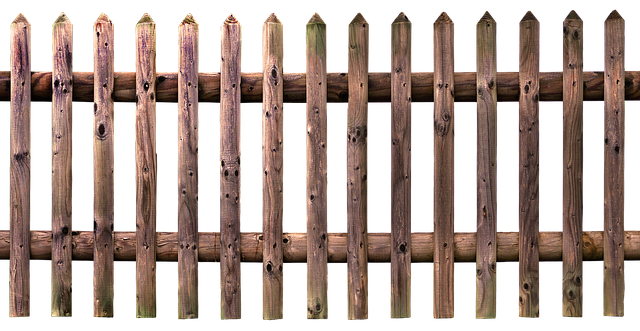- Understanding Fence Staining: Benefits and Types
- Preparing Your Wooden Fence for Staining
- Choosing the Right Stain: Color Options & Application
- Sealing Techniques: Protecting Your Fence Long-Term
- Step-by-Step Guide: Staining and Sealing Process
- Maintenance Tips: Keeping Your Fence Looking New
Understanding Fence Staining: Benefits and Types
Fence staining is a popular method to enhance the appearance and protect wooden fences. It involves applying a pigmented sealer or finish to the fence’s surface, available in various colors to match any aesthetic preference. The process offers multiple advantages; not only does it transform an ordinary fence into a visually appealing feature but also serves as a protective barrier against the elements. Over time, stains can protect wood from fading, cracking, and rot, ensuring your fence remains in top condition.
There are two primary types of fence staining: semi-transparent and solid. Semi-transparent stains allow some light to pass through, preserving the natural look of the wood while still providing protection. Solid colors, on the other hand, create a more dramatic effect, blocking light and offering complete coverage. Each type has its advantages, catering to different preferences and specific needs, making fence staining a versatile solution for any wooden fence.
Preparing Your Wooden Fence for Staining
Choosing the Right Stain: Color Options & Application
When choosing a fence stain, color is the first consideration. Various hues and shades are available, from natural wood tones to rich, dark colors. The right choice depends on your personal preference, the existing condition of your wooden fence, and the desired aesthetic effect. Lighter stains enhance the natural grain of the wood, while darker ones create a more dramatic look. Some stains offer subtle variations, allowing you to pick a unique color that complements your outdoor space.
Application is another crucial aspect. Stains can be applied using brushes, rollers, or sprayers. Each method has its advantages and will impact the overall finish. Brushes are ideal for detailed work and corners but may take longer. Rollers are efficient for larger areas, ensuring even coverage. Sprayers offer a fast and uniform application but require more preparation and protective gear. Reading product instructions carefully and testing on a small area first is recommended to ensure the best results.
Sealing Techniques: Protecting Your Fence Long-Term
When it comes to protecting your wooden fence, sealing is an essential step that often follows staining. Sealing techniques offer long-term protection against the elements and help maintain the vibrant color of your stain. A good seal acts as a barrier, preventing moisture, dirt, and UV rays from penetrating the wood’s surface.
Choosing the right sealing product depends on various factors, including the climate you live in and the type of fence. Water-based seals are popular due to their low odor and quick drying time, making them ideal for areas with high humidity. On the other hand, oil-based seals provide a stronger barrier against harsh conditions but take longer to dry and have a stronger scent. Regular reapplication is key to maintaining the seal’s effectiveness; typically, every one to two years, depending on exposure to sun and weather.
Step-by-Step Guide: Staining and Sealing Process
Staining and sealing your wooden fence is a straightforward process that can transform its appearance and protect it from the elements. Here’s a step-by-step guide to help you achieve professional results. First, clean your fence thoroughly to remove any dirt, dust, or debris using a pressure washer or a brush with mild detergent. Let the fence dry completely before proceeding.
Next, choose a suitable stain that matches your desired color and apply it evenly across the entire surface of the wood using a brush or a roller. Follow the manufacturer’s instructions regarding application times and drying periods between coats. Once the stain is dry, apply a layer of high-quality sealant to seal in the color and protect the wood from UV rays, moisture, and stains. Allow the sealant to dry fully before enjoying your refreshed, protected fence.
Maintenance Tips: Keeping Your Fence Looking New
Regular maintenance is key to keeping your wooden fence looking new and vibrant. After staining, it’s crucial to establish a cleaning routine, removing any dirt, mold, or mildew that may accumulate over time. A soft-bristled brush and mild soap mixed with water are ideal for this task. Rinse thoroughly afterward to prevent any residue from damaging the finish.
Additionally, applying a protective sealer every 1-2 years will extend the life of your fence’s stain. This step involves carefully following the manufacturer’s instructions for application. By sealing the wood regularly, you create a barrier against water, UV rays, and extreme temperatures, all of which can fade or deteriorate the color and texture of your fence over time.
